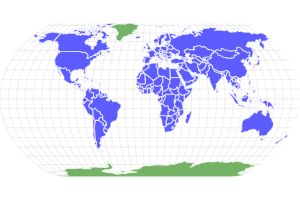Scorpion
Scorpiones
There are around 2,000 known species!
Advertisement
Scorpion Scientific Classification
- Kingdom
- Animalia
- Phylum
- Arthropoda
- Class
- Arachnida
- Order
- Scorpiones
- Family
- Scorpionoidea
- Scientific Name
- Scorpiones
Read our Complete Guide to Classification of Animals.
Scorpion Conservation Status
Scorpion Facts
- Main Prey
- Insects, Spiders, Small rodents
- Fun Fact
- There are around 2,000 known species!
- Habitat
- Dry desert, grassland, savanna and tropical jungles
- Diet
- Carnivore
- Average Litter Size
- 6
View all of the Scorpion images!
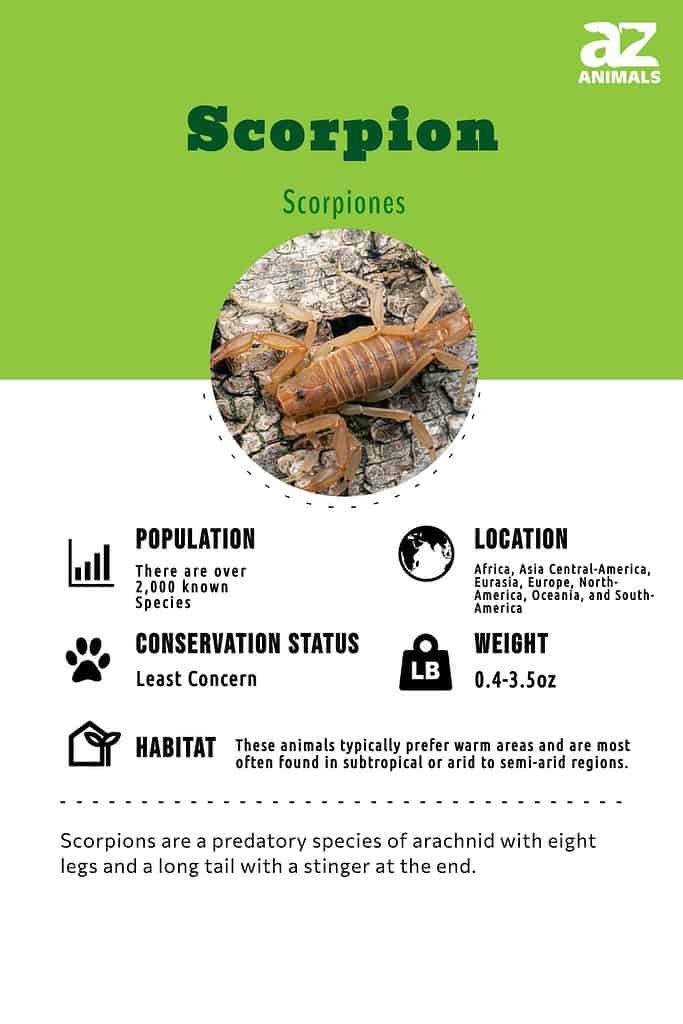
Scorpions are a predatory species of arachnid with eight legs and a long tail with a stinger at the end.
Two of the scorpion’s eight legs are in the form of pincers that look a bit like lobster claws. Scorpions are well-distributed all over the world, and they live on every continent except Antarctica. There are over 2,600 species of scorpions.
6 Incredible Scorpion Facts!
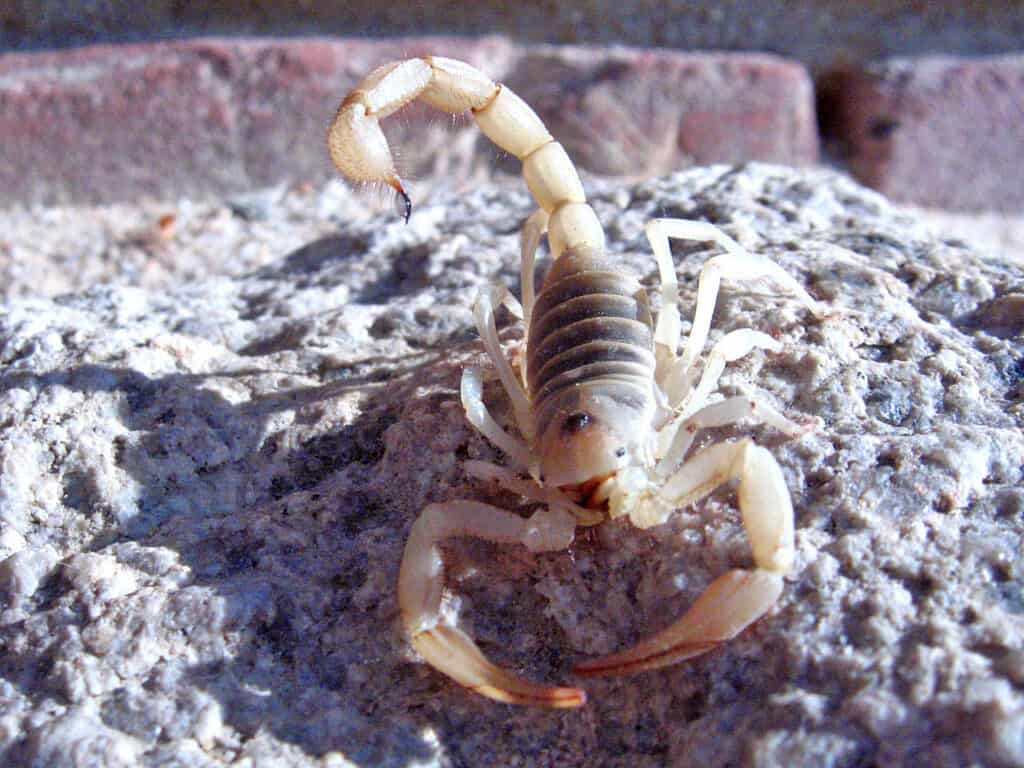
Most species of scorpions are not a serious threat to humans.
©Robb Hannawacker, while working for Joshua Tree National Park / CC BY 2.0 – License
Here are some awesome Scorpion facts:
- Most species of scorpions are not a serious threat to humans.
- Their exoskeletons have fluorescent chemicals that glow in ultraviolet light.
- People in places of Africa and East Asia often consume them as food.
- About 25 species of scorpions have venom deadly enough to kill a human.
- Some scorpions can squirt venom to ward off predators.
- The largest scorpion in the world is the giant forest scorpion. It can grow to more than 9 inches in length!
Evolution and Origins
Interestingly enough, Scorpions first appeared as an auatic organism in their evolutionary history. Studies suggest that they were certainly evolved from the Eurypterida. Since both groups share several common morphological features. In order to defend itself from prey animals, Scorpions had to develope a defense and method for hunting and eating.
Species, Types, and Scientific Names
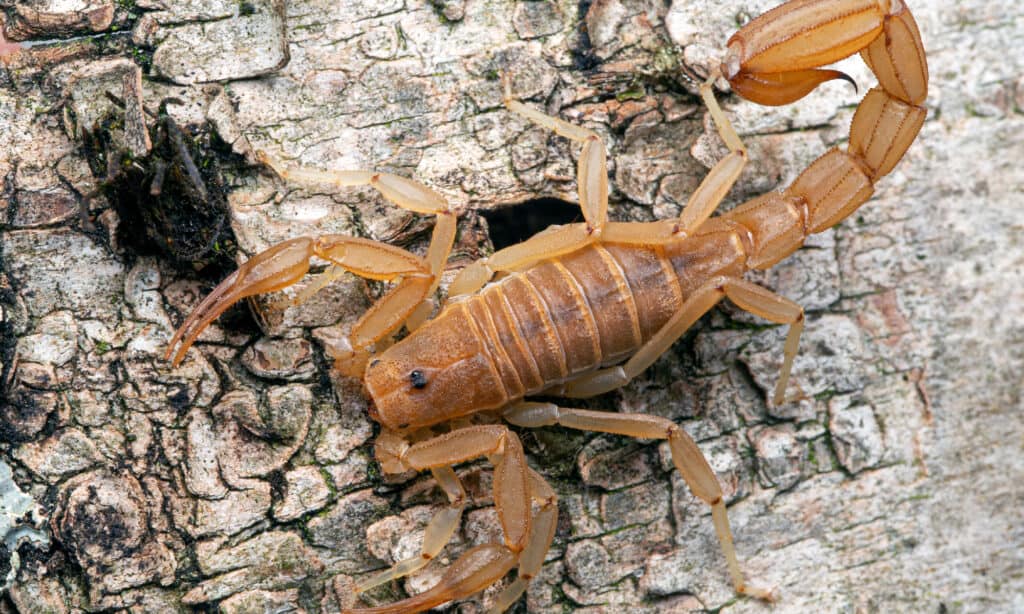
Scorpiones are predatory arthropods belonging to the Arachnida class and the order of Scorpiones.
©Ernie Cooper/Shutterstock.com
Scorpions are predatory arthropods belonging to the Arachnida class and the order of Scorpiones.
There are several families that fall under this order, including the following:
- Chaerilidae
- Pseudochactidae
- Buthoidea
- Iuridae
- Bothriuridae
- Chactidae
- Scorpionidae
There are over 2,650 described species, and the vast majority are found in subtropical areas and deserts. The scientific name varies by species.
For example, the scientific name of the giant forest scorpion is Heterometrus swammerdami, and it belongs to the Scorpiondae family.
The classification of scorpions commonly accepts that there are around 1,004 known species. However, the number may be greater than this, and some classifications are disputed.
The full classification is Kingdom Animalia, Phylum Arthropoda, Subphylum Chelicerata, Class Arachnida, and Order Scorpiones.
Additionally, different Scorpion types:
- Emperor scorpion
- Deathstalker
- Tityus serrulatus
- Brazilian scorpion
- Tetratrichobothrius flavicaudis
- Heterometrus
- Giant hairy scorpion
- Heterometrus spinifer
- Euscorpius italicus
- Bark scorpions
- Hottentotta tamulus
- Fattail scorpion
- Diplocentrus
- Caraboctonidae
- Pandinus
- Arrowbreasted scorpions
- Scorpionidae
- Euscorpius
- Brontoscorpio anglicus
- Flat rock scorpion
- Stripe-tailed scorpion
- Vaejovis
- Nebo hierichonticus
- Bothriurus
- Lurus
- Cercophonius squama
- Euscorpiidae
- Hadogenes
- Vaejovidae
- Kolotl
- Luridae
- Chaerilus
- Scorpionoidea
- Pseudochactoidea
- Chaeriloidea
- Chactoidea
- Belisarius
Appearance
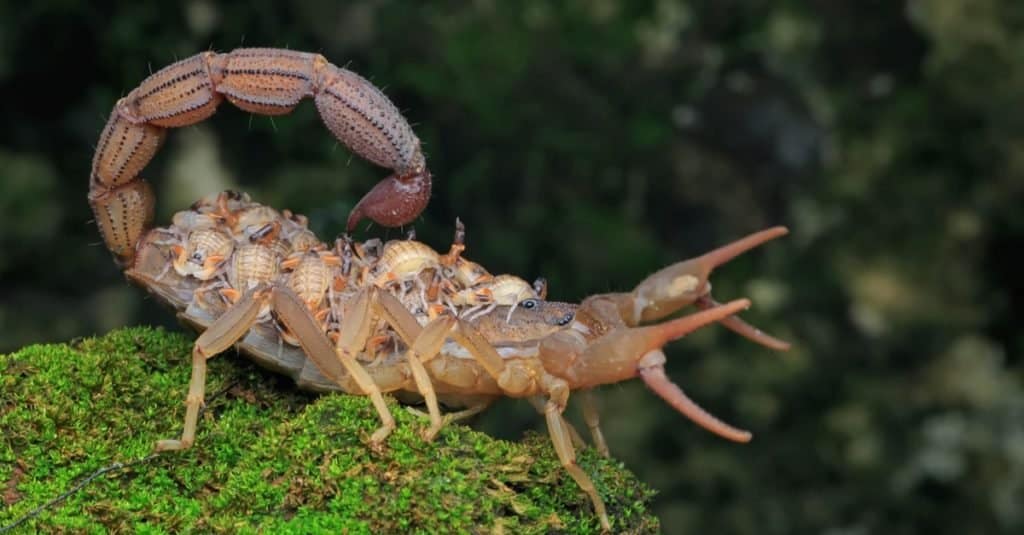
©I Wayan Sumatika/Shutterstock.com
Compared to other pest bugs or animals, scorpions are very easy to identify. The front pincers and the tail with a stinger are the main ways to identify them.
The largest species is the giant forest scorpion, which has the world record for size at nine inches long and a weight of two ounces. In general, the emperor scorpion is one of the largest species with an average length of nearly eight inches.
The emperor scorpion also has the distinction of having the largest pincers, which are very similar to a lobster.
Due to its large pincer size, the emperor scorpion has relatively weak venom. The smallest scorpion is a species found in Texas that measures only 23 millimeters. Most of these animals are around two inches in size.
Their coloring can vary based on where they live. They often blend into rocks, bark, and sand. Yellow and black are the most common colors of scorpions, but they can also be brown, red, or orange.
Desert scorpions tend to be lighter colors while forest scorpions are typically black. When under ultraviolet light, all of them will appear blue or blue-green.
They are largely solitary compared to bug pests like ants or bees. They tend to stay in holes or burrows by themselves. If they are found in groups, it’s likely due to recently born young scorpions.
Habitat
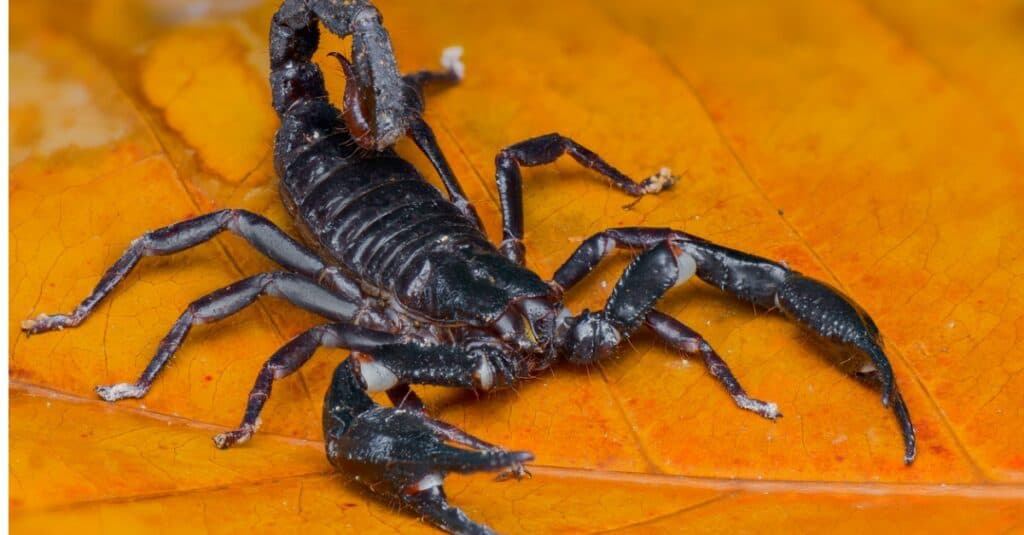
These animals typically prefer warm areas and are most often found in subtropical or arid to semi-arid regions.
©iStock.com/Dwi Yulianto
These animals typically prefer warm areas and are most often found in subtropical or arid to semi-arid regions. Every continent except Antarctica can claim some species of them. They often hide under rocks, logs, leaves, debris, or clutter.
It’s also common for them to dig burrows where they hide during the day. Some of them even use their burrows to ambush prey. If daytime temperatures are cool and moist, the animal might be more active. Otherwise, they typically only come out at night.
When it comes to finding these animals in human homes, it’s important to consider what they like in the wild. They can get into houses through gaps around doors and windows.
Since they like to hide under things in the wild, they will often hide behind and beneath things inside a house. Another place scorpions like to hide is in shoes. These animals can climb quite well and may also climb into hanging clothes.
They can’t climb on smooth glass. Placing wide-mouth jars beneath the table and crib legs can keep them from climbing in these areas. Another deterrent is covering the legs with petroleum jelly.
Diet
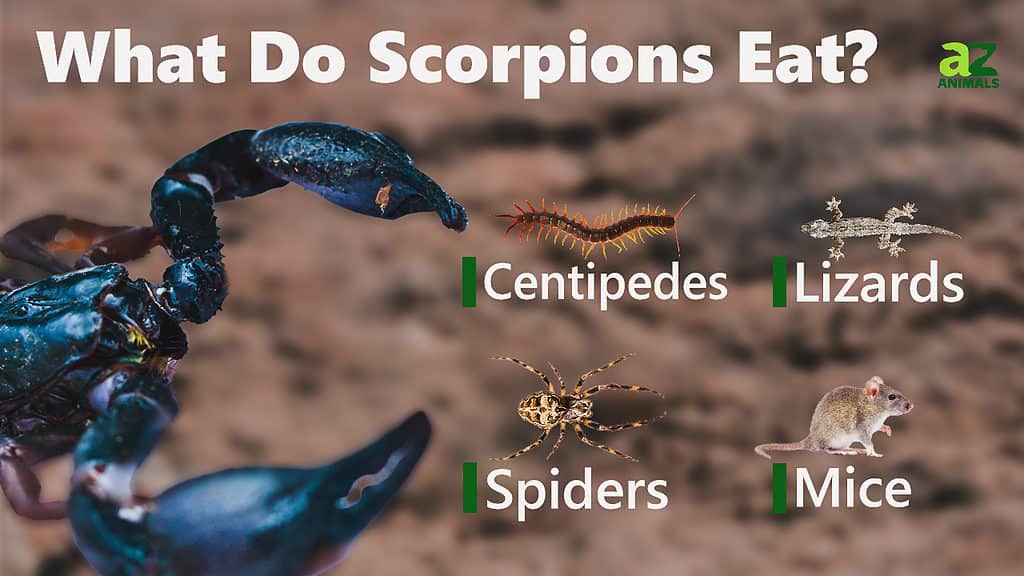
These animals prey mainly on bugs such as grasshoppers, termites, beetles, and wasps. They may also eat other arachnids, including other scorpions. Large species sometimes prey on animals such as small reptiles and mammals.
Different types hunt and kill prey in different ways. For example, species with large powerful pincers will use their pincers to crush prey.
Scorpions with smaller pincers but stronger venom will sting their prey. Some of them chase or ambush prey while others wait in burrows.
These animals can survive a long time without food due to their slow metabolic rate, general inactivity, and efficient biological method of food storage. Some of them can survive six months to a year without food.
What eats scorpions?
Many animals actively prey on and eat them. Main predators include lizards, birds, snakes, frogs, rodents, and bats.
Some mammals like meerkats and long-eared bats are immune to their venom. They also eat other scorpions, and large spiders will prey on smaller scorpions as well.
What do scorpions eat?
These animals eat all manner of insects as well as other arachnids. Very large species may also prey on small reptiles and rodents.
Prevention
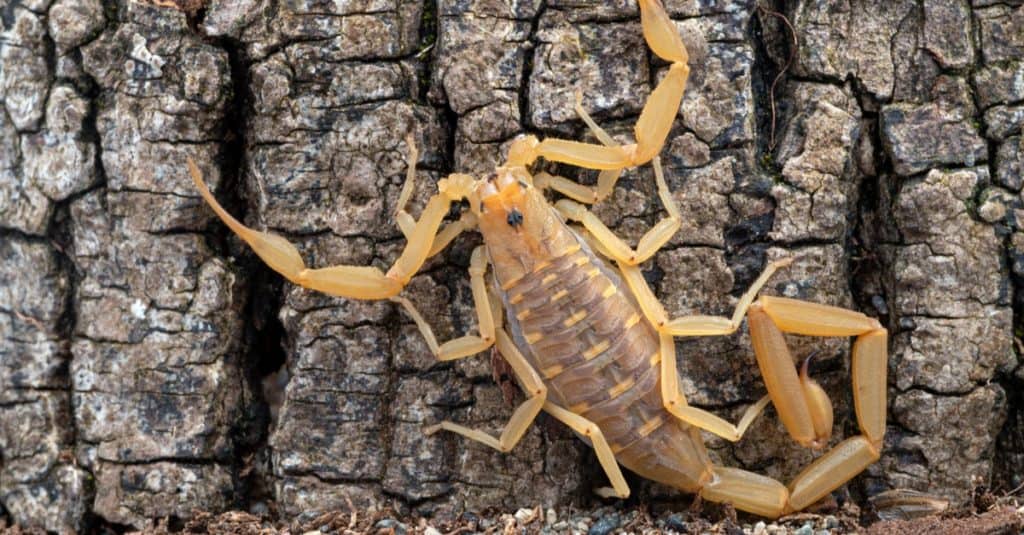
If you live in an area with these animals, it’s best to prevent them from entering your house by plugging up gaps.
©Ernie Cooper/Shutterstock.com
If you live in an area with these animals, it’s best to prevent them from entering your house by plugging up gaps around doors, windows, wires, and pipes. Keep organic litter away from your house as it’s a place where scorpions like to hide.
Expose the trunk and ground around shrubs and trees by pruning. Piles of rocks or firewood are also places where they like to hide. Use tight-fitting screens on all windows and doors and make sure that your air conditioner doesn’t leak.
Avoiding stings inside means not walking around at night with bare feet. Use an ultraviolet flashlight to shine in dark corners. Always check shoes and clothing before wearing them as these are favorite spots for them to hide. If you find one of them on your body, don’t swat at them but brush them off.
Insecticides can be used against these animals as well. This should be sprayed around the house perimeter as well as near entry points, inside around baseboards, inside closets, around plumbing, and in the garage and/or basement.
View all 293 animals that start with SScorpion FAQs (Frequently Asked Questions)
What's the difference between scorpions and camel spiders?
Camel spiders and scorpions both live in arid areas, but are very different animals. Both are incredibly diverse, with more than 1,000 species of camel spiders and scorpions. However, while scorpions can be venomous camel spiders are not.
Are Scorpions herbivores, carnivores, or omnivores?
Scorpions are Carnivores, meaning they eat other animals.
What Kingdom do Scorpions belong to?
Scorpions belong to the Kingdom Animalia.
What class do Scorpions belong to?
Scorpions belong to the class Arachnida.
What phylum to Scorpions belong to?
Scorpions belong to the phylum Arthropoda.
What order do Scorpions belong to?
Scorpions belong to the order Scorpiones.
In what type of habitat do Scorpions live?
Scorpions live in dry desert, grassland, savannas, and tropical jungles.
What is the main prey for Scorpions?
Scorpions prey on insects, spiders, and small rodents.
What are some predators of Scorpions?
Predators of Scorpions include rodents, birds, and lizards.
How many babies do Scorpions have?
The average number of babies a Scorpion has is 6.
What is an interesting fact about Scorpions?
There are around 2,000 known species of Scorpion!
What is the scientific name for the Scorpion?
The scientific name for the Scorpion is Scorpiones.
What is the lifespan of a Scorpion?
Scorpions can live for 4 to 25 years.
How fast is a Scorpion?
A Scorpion can travel at speeds of up to 12 miles per hour.
Are Scorpions dangerous?
Most scorpions are not particularly dangerous aside from delivering painful stings or bites. Only about 25 species have dangerous venom.
How many legs does a Scorpion have?
Technically, a scorpion has eight legs as it’s an arachnid, however, two of the legs actually work as pincers. Functionally, it appears as though the scorpion has three legs on each side of its body.
How do you identify Scorpions?
Scorpions are easily identifiable by their claw-like pincers in the front and a long, segmented tail with a stinger at the end. They range in color from black to pale yellow.
How do you get rid of Scorpions?
Sprays that kill scorpions are available. Scorpions are more attracted to houses where they can find small insect prey such as termites, flies, and ants.
What scorpion can kill a human?
The Arizona bark scorpion and the deathstalker scorpion have poison that is strong enough to kill a human. There are around 25 total species of scorpion that can do this.
Are Scorpions good for anything?
Scorpions prey on insects, so they may be helpful in getting rid of pest insects. They also eat other scorpions.
Where do scorpions live?
Scorpions mostly live in deserts or semi-arid regions.
How can you tell if a scorpion is poisonous?
A rule of thumb in judging a poisonous scorpion is the size of its tail and pincers. A scorpion with a thick tail and small pincers is likely to be a venomous species.
What family are scorpions in?
Scorpions are in the animal family Scorpionoidea.
How fast can a scorpion run?
Scorpions can move at a speed of 12 mph, which makes it easy for them to scurry away from attacks.
What is the deadliest scorpion?
The deathstalker scorpion is the world’s deadliest scorpion. It belongs to the family Buthidae and is also called the Palestine yellow scorpion among other names.
How long do scorpions live?
Scorpions typically live for at least two to six years but may live much longer.
Can a dead scorpion sting or bite you?
It’s possible for a dead scorpion’s sting to activate, so it’s best to pick them up with a broom and dustpan. Scorpions don’t actually bite, but some people use a bite to describe a sting.
Who would win a fight: Tarantula vs Scorpion?
The scorpion would win the fight against a tarantula.
When weighing the advantages of each species separately, the odds seem even in a fight between a scorpion and a tarantula. But when weighed together, the scorpion’s speed, tough exoskeleton, and deadly venom all point to a clear winner. Despite the tarantula’s size advantage, the scorpion is capable of a quick, deadly attack that makes it one of the most dangerous arachnids in the world.
What are the key differences between a vinegaroon and a scorpion?
The most significant differences between a vinegaroon and a scorpion are their size and appearance. Other differences include habitat, mating behavior, venom, litter size, and lifespan.
Thank you for reading! Have some feedback for us? Contact the AZ Animals editorial team.
Sources
- Wikipedia, Available here: https://en.wikipedia.org/wiki/Scorpion
- African Snakebite Institute, Available here: https://www.africansnakebiteinstitute.com/articles/how-to-identify-a-potentially-dangerous-scorpion/
- Orkin, Available here: https://www.orkin.com/stinging-pests/scorpions/scorpion-habitat
- Animals.mom, Available here: https://animals.mom.com/scorpion-sizes-8678.html

